The NOAA Corps: A Vision for the Next 20 Years
The NOAA Commissioned Officer Corps is a uniformed service of the United States consisting of approximately 299 commissioned officers. Today's NOAA Corps officers serve at sea aboard NOAA's research and survey fleet, in flight aboard research aircraft, and ashore in NOAA's labs and offices across the U.S. They work across all divisions of NOAA, regularly working cooperatively with the U.S. Coast Guard and Department of Defense.
The captain of the NOAA ship Rainier, a NOAA Corps officer, stared intently at the sounding plot. After weeks of measuring water depths in the pristine fjords of southeast Alaska, the preliminary survey revealed a rocky and dangerous shoal, one that could rip open a cruise ship like a can opener.
Had the survey discovered the least depth over the shoal or was further investigation needed?
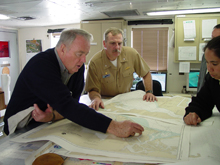
Rainier's NOAA Corps commanding officer has final say on critical decisions involving surveys, navigation, and all other ship operations. Click image for larger view.
Russian explorers had surveyed the area over 150 years ago with leadlines and sextants and did not detect the rocky shoal. However, Rainier, equipped with sophisticated sonars, collected thousands of soundings over the shoal. The NOAA Corps officer, a skilled mariner, a manager, a leader, and a professional ocean surveyor, used his years of experience in deciding whether or not to survey on.
NOAA Corps officers are called upon to make similar critical decisions every day. They are trained in the operation of ships and aircraft; in the conduct of field projects; in the management of NOAA observational and support facilities; as members or leaders of research efforts; and in the management of various organizational elements throughout NOAA.
The above describes the NOAA Corps of today. What will the NOAA Corps look like in 20 years?
Evolving to Meet Future Needs
The NOAA Corps of the future, like the service today, will be responsive to the new challenges that face NOAA. The priorities established by the Administrator of NOAA will always be the priorities for the NOAA Corps. Historically, the NOAA Corps has been at the vanguard of operating NOAA ships and aircraft; incorporating new data acquisition technologies; and providing specialized personnel who are responsive to NOAA programs.
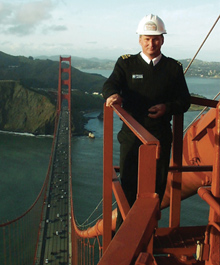
The strength of the NOAA Corps lies in its ability to see the big picture across all divisions of NOAA. In the image above, an officer finishes installing a global positioning system receiver on the Golden Gate Bridge.
While the basic mission of the NOAA Corps has not dramatically changed over time, the way in which that mission is accomplished undergoes constant transformation. Twenty years ago, the global positioning system (GPS) was a developmental positioning system and the Internet was a computer network for university professors. Today, both are invaluable tools for everyone in the scientific community. Twenty years from now, we can expect similar technological advancements to radically change the way NOAA Corps officers accomplish their mission.
New Ships and Integrated Operations
In recent years, NOAA has revitalized its fleet with new vessel acquisitions and conversions. This ensures that the NOAA fleet, and NOAA Corps officers, will remain an important element in ocean-based observation systems well into the 21st century. In the past several years, two new state-of-the-art fisheries survey vessels have been built for NOAA, with two others under construction.
A new, small water-plane-area twin hull (or SWATH) coastal mapping vessel is being built and will support NOAA's mapping and charting programs. Also, a 224-foot former Navy T-AGOS ship is in the process of being converted to the NOAA ship Okeanos Explorer. It is NOAA's vision that the converted ship will become the international symbol vessel for ocean exploration and research.
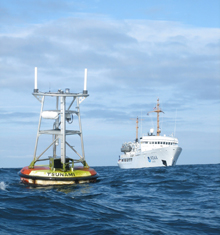
Fairweather, a decommissioned hydrographic survey ship, was recently refurbished and reactivated. It now has multiple capabilities that enabled it to recover a lost tsunami buoy in 2005. Click image for larger view.
Rear Admiral Samuel P. De Bow, Jr., Director of NOAA's Office of Marine and Aviation Operations and NOAA Commissioned Officer Corps, has stated that NOAA can be better served each day if the agency's ships support integrated programs. In order to meet this challenge, NOAA officers who serve in command and management positions must be prepared by having a background that includes broad NOAA experience.
In the future, for example, officers serving aboard fisheries ships will require experience in mapping and charting data acquisition technology. Officers who have spent most of their careers specializing in hydrography may need to know how to retrieve a lost tsunami buoy, or provide support for biological or oceanographic observation projects. NOAA Corps officer specialization will still be required. However, officers must develop experience in a broader range of NOAA programs in order to meet the challenge of supporting integrated operations.
Unmanned Observation Systems
NOAA is moving rapidly toward a next generation of observation instrumentation that will be deployed on unmanned platforms. Autonomous Underwater Vehicles (AUVs) will certainly play a significant role in future underwater mapping and charting operations. NOAA's Office of Coast Survey is already testing AUV systems that can be deployed to conduct side scan sonar surveys at a fraction of the cost of using a dedicated hydrographic survey ship.
Similarly, Unmanned Aircraft Systems (UAS) offer possibilities for new research and operational applications that could greatly broaden NOAA's ability to acquire data. In September 2005, NOAA, the National Aeronautics and Space Administration, and industry partners successfully flew an Aerosonde UAS into Tropical Storm Ophelia. This marked the first time a UAS had flown into a tropical storm. The mission demonstrated the unique capabilities of UAS to document areas of the tropical storm environment near the surface of the ocean that have historically been either impossible, or impractical, to routinely observe by hurricane hunter aircraft.
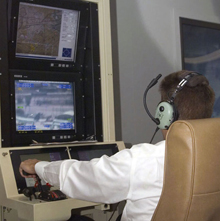
NOAA Corps pilots will play an important operational and advisory role if NOAA decides to use unmanned aircraft systems in the future. Click image for larger view.
Will unmanned observation systems make the NOAA Corps obsolete? Will there be no more need for officers to operate ships and aircraft?
On the contrary, unmanned systems will need to be deployed and monitored by people who understand field data acquisition operations. There will be opportunities for NOAA Corps officers who possess experience in marine and aircraft operations to play a crucial role in the operational development of these systems. Unmanned systems will enhance NOAA's observational capabilities in the future, but it is unlikely that these systems will replace the need for manned aircraft and marine observation platforms.
Global Earth Observation System of Systems
Producing better information on the environment has become a growing priority around the world. To meet that need, NOAA is aiding in the development of the Global Earth Observation System of Systems (GEOSS). GEOSS would bring together many thousands of Earth observation sources and datasets, to create one network for the distribution of data and information products and services.
Today, there are thousands of moored and free-floating data buoys in the world's oceans, thousands of land-based environmental stations, and more than 50 environmental satellites orbiting the globe, all providing millions of data sets. Most of these technologies do not yet "talk" to each other. Until they do—and all of the individual technology is connected as one comprehensive system—there will always be blind spots and scientific uncertainty about the state of the world's air, water, land, and ecosystems.
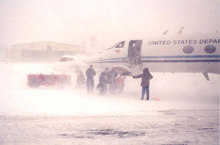
NOAA Corps pilots and civilian crews are highly trained to operate in all kinds of weather to acquire essential data for NOAA now and into the future. Here, the NOAA aircraft Gulfstream IV-SP, or G-IV, conducts winter storms research in Alaska. Click image for larger view.
The challenge is to connect the scientific dots—to build a powerful "system of systems" that will collect the scientific information needed to make informed policy and other decisions.
NOAA Corps officers can play a leading role in helping NOAA promote development of GEOSS, because the NOAA Corps has always been about "connecting the dots."
The NOAA Corps officer rotates assignments between the field and the office, thereby affording that officer a view of the "big picture" within NOAA. The officer aboard a ship understands the reason for new data acquisition procedures because that officer has spent time in the office developing similar procedures. Likewise, the officer working in the office developing scientific flight plans understands the operational capabilities and limitations of a particular aircraft, because the officer has flown that aircraft.
The NOAA Corps gives NOAA a group of individuals who are trained to look at the big picture. They are trained to bridge organizational boundaries. They are trained to "connect the dots."
NOAA Corps Values: A Beacon for the Future
Over the years, the NOAA Corps shirt color and the uniform have changed. Officers were once allowed to grow beards but now are only permitted mustaches. However, the values of the NOAA Corps have not changed:
Honor: Abide by an uncompromising code of integrity.
Respect: Commit to treat each individual with human dignity.
Commitment: Commit and dedicate ourselves to the nation and NOAA.
These are the values that will guide the NOAA Corps into a bright future, as officers continue to serve the agency at sea, in flight, and on shore. NOAA Corps officers will apply their operational expertise, broad organizational knowledge, and leadership abilities to serve the changing needs of NOAA.
Contributed by Captain Nick Perugini, NOAA (ret.)
